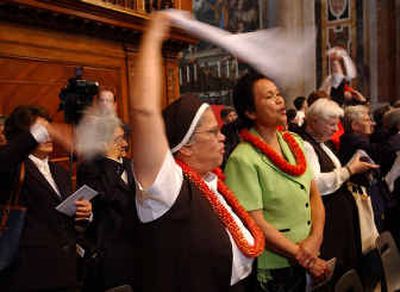Vatican beatifies nuns

VATICAN CITY – A German-born nun who cared for leprosy patients on a Hawaiian island and a Spanish nun who started a missionary society were beatified Saturday in St. Peter’s Basilica in a ceremony led by a top Vatican cardinal representing Pope Benedict XVI.
Benedict’s decision not to preside over the ceremony marks a shift from Pope John Paul II, who beatified and canonized more faithful than all his predecessors over the past 500 years combined. John Paul, weather permitting, would hold his saint-making ceremonies in St. Peter’s Square on Sunday mornings to encourage huge turnouts.
Benedict designated Cardinal Jose Saraiva Martins to lead the beatification ceremony marking the last formal step before possible sainthood. The cardinal heads the Vatican’s Congregation for the Causes of the Saints.
Mother Marianne Cope, who was born in Germany and raised in New York, went to Hawaii in 1883 as a Franciscan nun to work with leprosy patients. She died in 1918 at age 80. Robert Louis Stevenson, author of “Treasure Island,” wrote a poem in tribute to her.
Honored with her Saturday was the co-founder of a missionary society in Spain, Ascensione del Cuore di Gesu. Born Ascension Nicol Goni in Tafalla-Navarra, Spain, in 1868, she helped establish the Dominican Missionary Nuns of the Rosary and died in 1940.
The cardinal praised her as “one of the greatest missionaries of the past century.”
Mother Marianne was born Barbara Koob in 1838 in Germany. The following year, her family emigrated to upstate New York and became American citizens. She entered the Sisters of St. Francis in Syracuse, N.Y., in 1862.
In 1883, Cope and six other Franciscan sisters volunteered to work at the Kalaupapa settlement on Molokai with leprosy patients alongside the Belgian missionary Father Damien DeVeuster, who was beatified by John Paul in 1995. She left a legacy of schools and orphanages, and the Sisters of St. Francis have cared for leprosy patients on Molokai since then.
Today, about three dozen leprosy – or Hansen’s disease – patients still live there.
Hundreds of pilgrims, including dozens from Hawaii and a large contingent of the Sisters of St. Francis, her Syracuse-based order, attended the ceremony with thousands of other faithful in the basilica.
Some participants wore traditional Hawaiian floral leis.
“I have shivers to think that someone who did common, ordinary things can become a saint,” said Sister Grace, a Franciscan nun who was part of a 150-member delegation from Hawaii.
Jerry Omakanim, wearing an aloha shirt and a lei, came from the island of Oahu for the ceremony.
“Today I’m really proud to be a Catholic and this is a great day for Hawaii and for the Franciscan sisters who made all those sacrifices for us,” he said.
Formally asking for Cope’s beatification was Syracuse Bishop James Moynihan.
” ‘I am not afraid of any disease,’ ” Moynihan quoted Cope as saying. ” ‘It will be my greatest delight to minister to the abandoned leper.’ “
In his homily, Saraiva Martins said her life was a “wonderful work of divine grace.”
“She put her own health and life at risk,” the cardinal said.
To be beatified, a miracle attributed to the candidate’s intercession after death must be approved by the pontiff. In December, John Paul approved the healing of a Syracuse teenager who had suffered multiple organ failure. The girl had recovered after she was touched by a relic of Cope.
Before canonization, or sainthood, is conferred, another miracle, happening after beatification, must be certified by the Vatican.
The beatification ceremony was on the Vatican schedule before Benedict was elected pope, although the date changed after John Paul died April 2.
Saraiva Martins has said that Benedict, in designating a stand-in for the beatification, was reverting to an accepted practice before John Paul, in which the pope would celebrate canonization ceremonies but designate a bishop or cardinal to lead those for beatification.